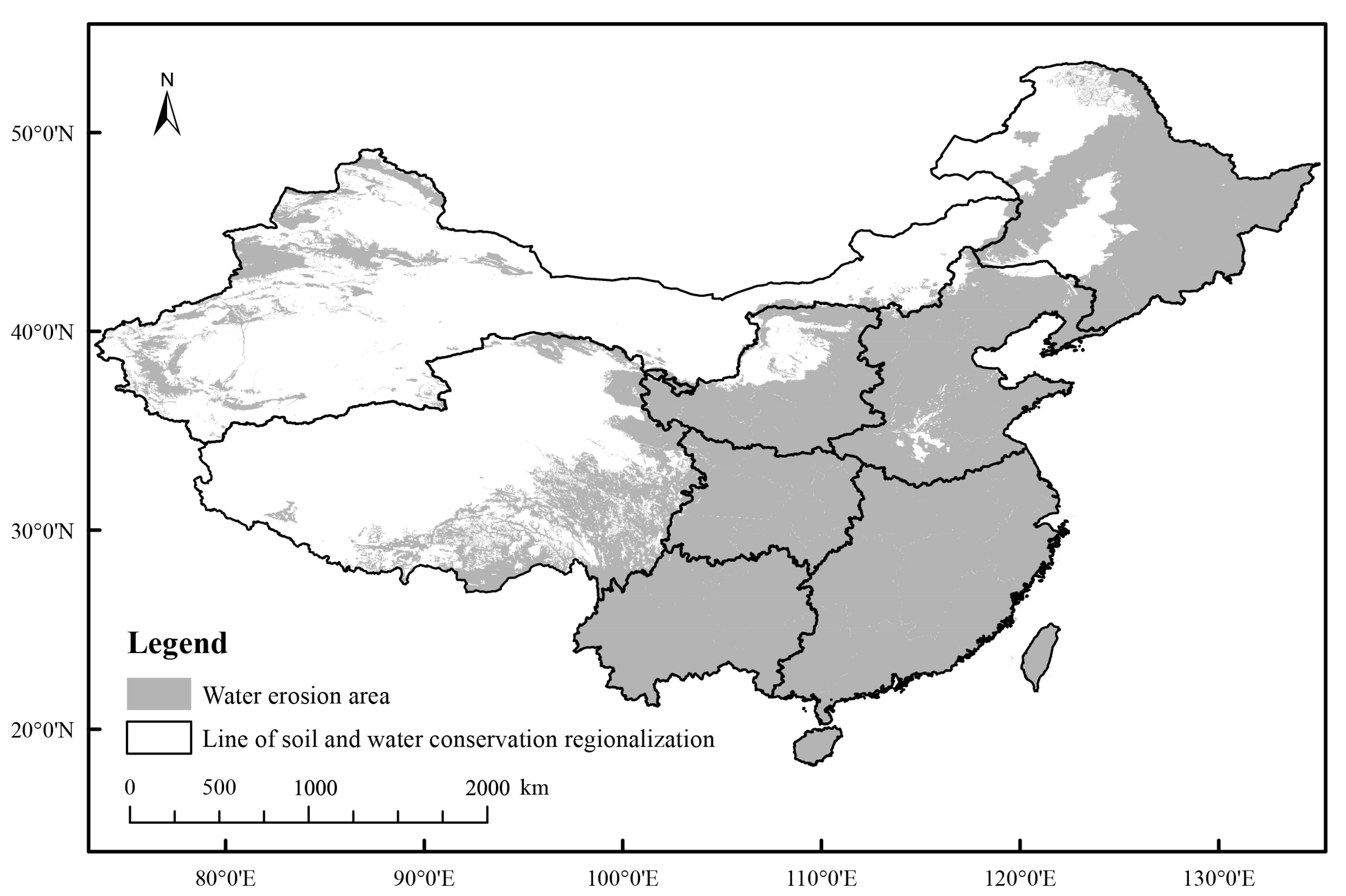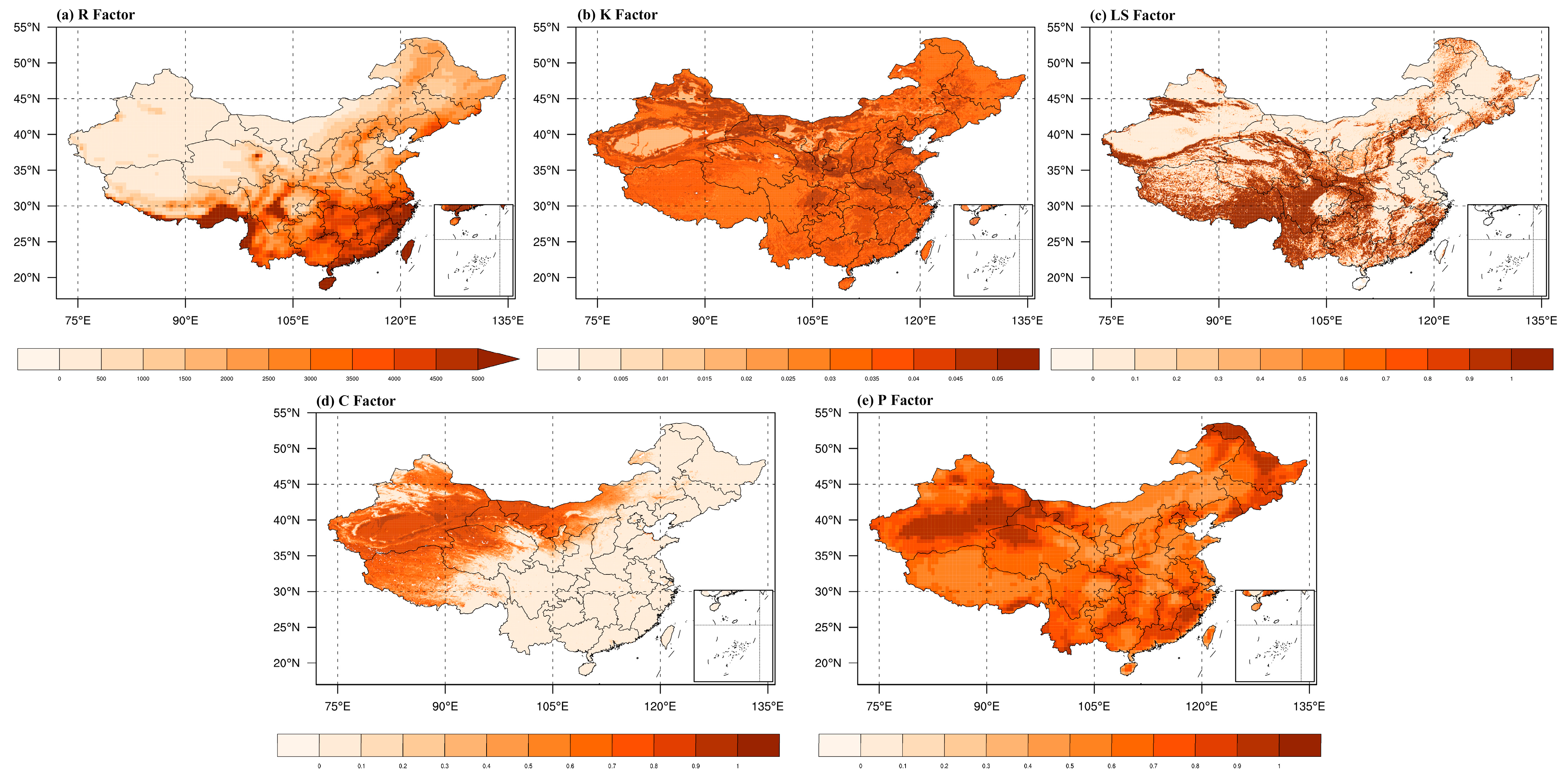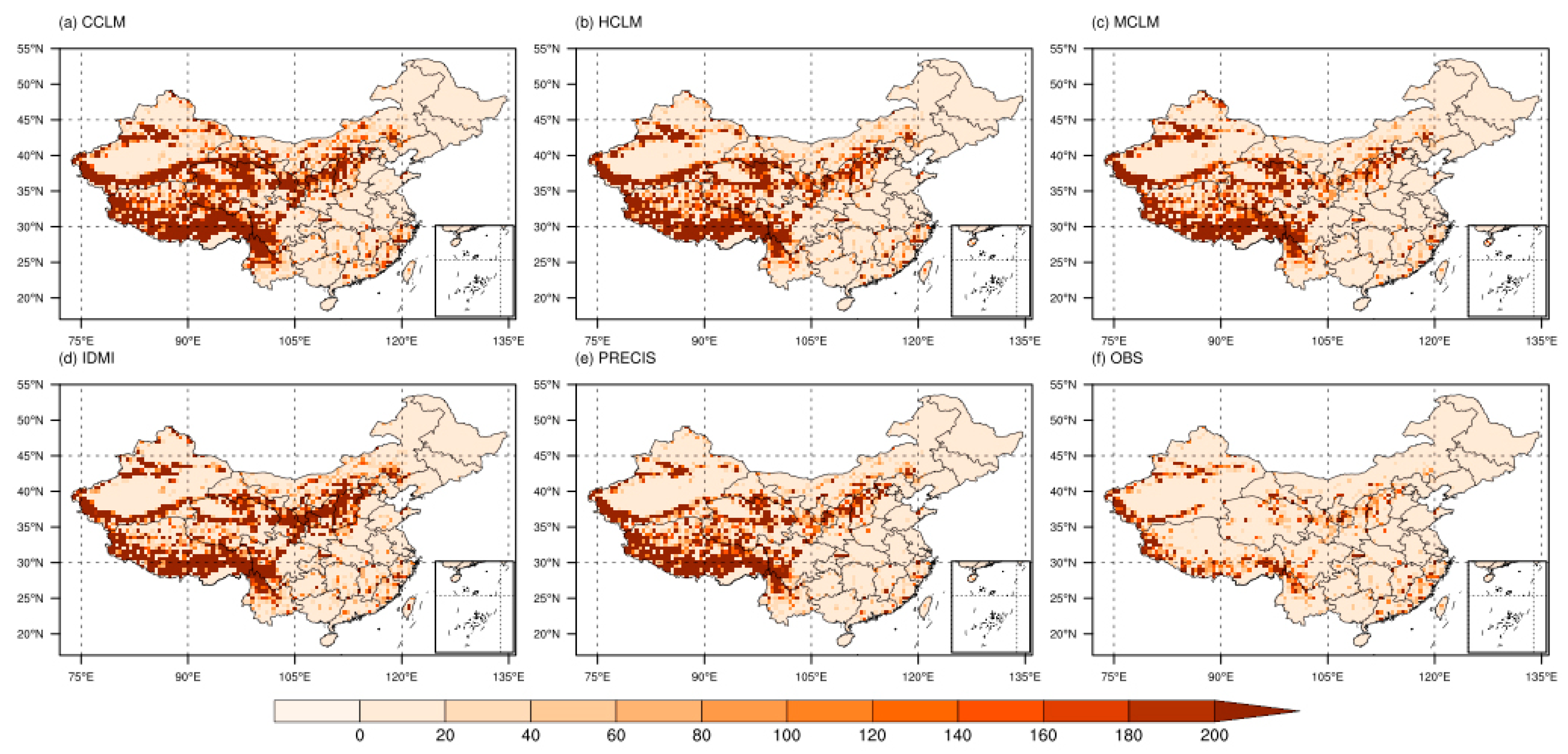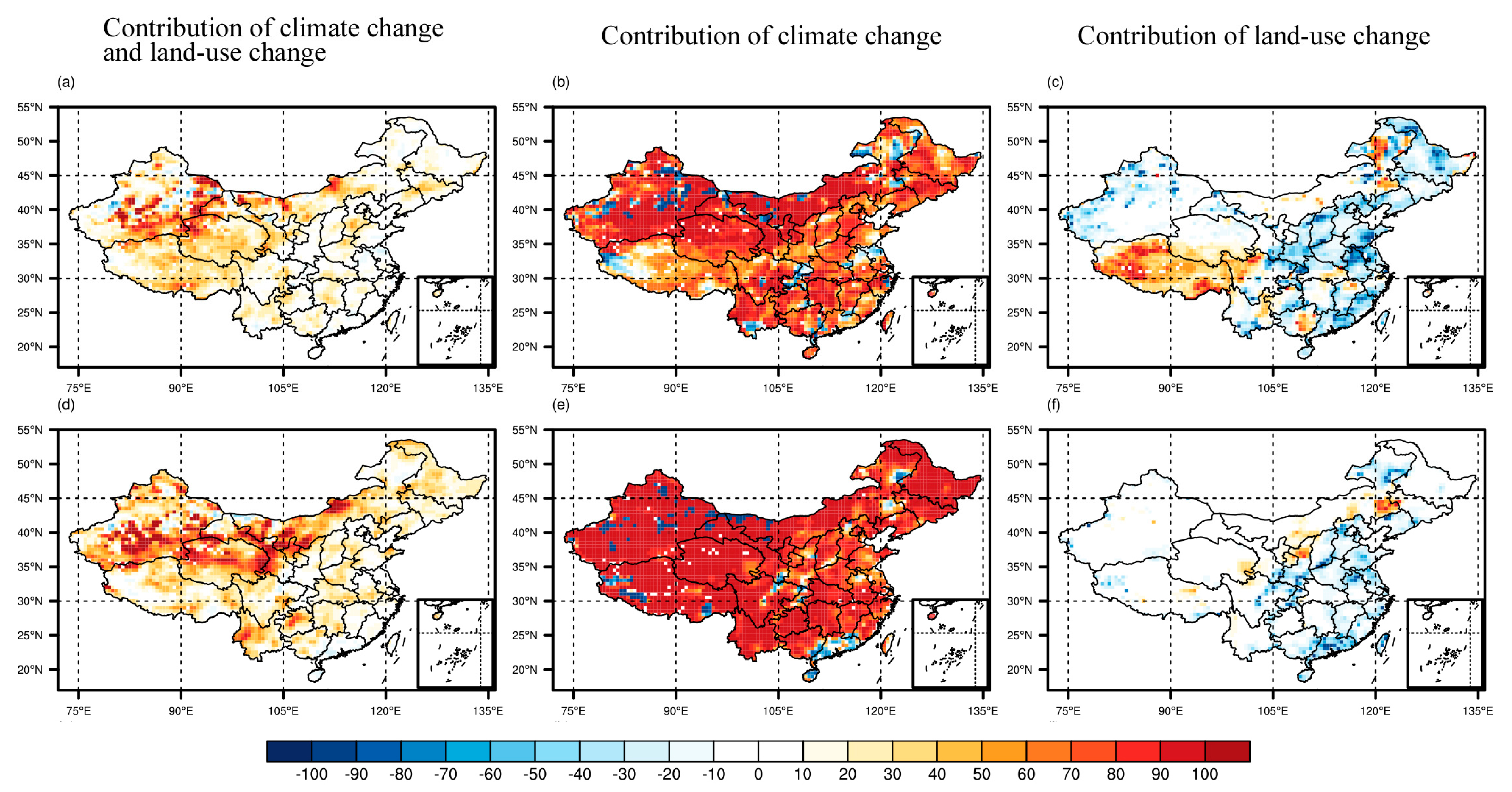Assessing Land Use and Climate Change Impacts on Soil Erosion Caused by Water in China
Abstract
1. Introduction
2. Data and Methods
2.1. Study Area
2.2. Data Used
2.3. RUSLE Model
- (1)
- Rainfall erosivity (R factor)
- (2)
- Soil erodibility (K factor)
- (3)
- Slope length–steepness factor (LS factor)
- (4)
- Cover management factor (C factor)
- (5)
- Conservation support practice factor (P factor)
2.4. Bayesian Model Averaging Method
2.5. Contribution of Climate and Land-Use Change to Soil Erosion
2.6. Classification of Soil Erosion Intensity
3. Results
3.1. Historical Simulation of Soil Erosion
3.2. Future Projections of Soil Erosion
3.3. Impacts of Climate and Land-Use Changes on Soil Erosion
4. Discussion
4.1. The Main Driving Forces Affecting Soil Erosion
4.2. Limitations
5. Conclusions
Supplementary Materials
Author Contributions
Funding
Institutional Review Board Statement
Informed Consent Statement
Data Availability Statement
Conflicts of Interest
References
- Gibbs, H.K.; Salmon, J.M. Mapping the world’s degraded lands. Appl. Geogr. 2015, 57, 12–21. [Google Scholar] [CrossRef]
- Shao, Y.; Jiang, Q.; Wang, C.; Wang, M.; Xiao, L.; Qi, Y. Analysis of critical land degradation and development processes and their driving mechanism in the Heihe River Basin. Sci. Total Environ. 2020, 716, 137082. [Google Scholar] [CrossRef] [PubMed]
- Nkonya, E.; Mirzabaev, A.; Braun, J.V. Economics of Land Degradation and Improvement—A Global Assessment for Sustainable Development; Economics and Finance; Springer Nature: Berlin/Heidelberg, Germany, 2016. [Google Scholar]
- Montanarella, P.; Scholes, R.; Brainich, A. The IPBES Assessment Report on Land Degradation and Restoration; Secretariat of the Intergovernmental Science-Policy Platform on Biodiversity and Ecosystem Services: Bonn, Germany, 2018. [Google Scholar]
- Amundson, R.; Berhe, A.A.; Hopmans, J.W.; Olson, C.; Sztein, A.E.; Sparks, D.L. Soil and human security in the 21st century. Science 2015, 348, 1261071. [Google Scholar] [CrossRef] [PubMed]
- Azari, M.; Oliaye, A.; Nearing, M.A. Expected climate change impacts on rainfall erosivity over Iran based on CMIP5 climate models. J. Hydrol. 2021, 593, 125826. [Google Scholar] [CrossRef]
- IPCC. Climate Change 2014: Impacts, Adaptation, and Vulnerability. Contribution of Working Group II to the Fifth Assessment Report of the Intergovernmental Panel on Climate Change; IPCC: Geneva, Switzerland, 2014. [Google Scholar]
- Qiu, J.; Crow, W.T.; Wang, S.; Dong, J.; Li, Y.; Garcia, M.; Shangguan, W. Microwave-based soil moisture improves estimates of vegetation response to drought in China. Sci. Total Environ. 2022, 849, 157535. [Google Scholar] [CrossRef]
- Feng, S.; Qiu, J.; Crow, W.T.; Mo, X.; Liu, S.; Wang, S.; Gao, L.; Wang, X.; Chen, S. Improved estimation of vegetation water content and its impact on L-band soil moisture retrieval over cropland. J. Hydrol. 2023, 617, 129015. [Google Scholar] [CrossRef]
- Li, Z.; Fang, H. Impacts of climate change on water erosion: A review. Earth-Sci. Rev. 2016, 163, 94–117. [Google Scholar] [CrossRef]
- David Raj, A.; Kumar, S.; Sooryamol, K.R. Modelling climate change impact on soil loss and erosion vulnerability in a watershed of Shiwalik Himalayas. Catena 2022, 214, 106279. [Google Scholar] [CrossRef]
- Marcinkowski, P.; Szporak-Wasilewska, S.; Kardel, I. Assessment of soil erosion under long-term projections of climate change in Poland. J. Hydrol. 2022, 607, 127468. [Google Scholar] [CrossRef]
- Mullan, D.; Favis-Mortlock, D.; Fealy, R. Addressing key limitations associated with modelling soil erosion under the impacts of future climate change. Agric. For. Meteorol. 2012, 156, 18–30. [Google Scholar] [CrossRef]
- Pandey, A.; Himanshu, S.K.; Mishra, S.K.; Singh, V.P. Physically based soil erosion and sediment yield models revisited. Catena 2016, 147, 595–620. [Google Scholar] [CrossRef]
- Schürz, C.; Mehdi, B.; Kiesel, J.; Schulz, K.; Herrnegger, M. A systematic assessment of uncertainties in large-scale soil loss estimation from different representations of USLE input factors—A case study for Kenya and Uganda. Hydrol. Earth Syst. Sci. 2020, 24, 4463–4489. [Google Scholar] [CrossRef]
- Jin, F.; Yang, W.; Fu, J.; Li, Z. Effects of vegetation and climate on the changes of soil erosion in the Loess Plateau of China. Sci. Total Environ. 2021, 773, 145514. [Google Scholar] [CrossRef] [PubMed]
- Wang, J.; Lu, P.; Valente, D.; Petrosillo, I.; Babu, S.; Xu, S.; Li, C.; Huang, D.; Liu, M. Analysis of soil erosion characteristics in small watershed of the loess tableland Plateau of China. Ecol. Indic. 2022, 137, 108765. [Google Scholar] [CrossRef]
- Teng, H.; Liang, Z.; Chen, S.; Liu, Y.; Viscarra Rossel, R.A.; Chappell, A.; Yu, W.; Shi, Z. Current and future assessments of soil erosion by water on the Tibetan Plateau based on RUSLE and CMIP5 climate models. Sci. Total Environ. 2018, 635, 673–686. [Google Scholar] [CrossRef] [PubMed]
- Guo, Y.; Peng, C.; Zhu, Q.; Wang, M.; Wang, H.; Peng, S.; He, H. Modelling the impacts of climate and land use changes on soil water erosion: Model applications, limitations and future challenges. J. Environ. Manag. 2019, 250, 109403. [Google Scholar] [CrossRef]
- Maruffi, L.; Stucchi, L.; Casale, F.; Bocchiola, D. Soil erosion and sediment transport under climate change for Mera River, in Italian Alps of Valchiavenna. Sci. Total Environ. 2022, 806, 150651. [Google Scholar] [CrossRef] [PubMed]
- Zhang, Y.G.; Nearing, M.A.; Zhang, X.C.; Xie, Y.; Wei, H. Projected rainfall erosivity changes under climate change from multimodel and multiscenario projections in Northeast China. J. Hydrol. 2010, 384, 97–106. [Google Scholar] [CrossRef]
- Doulabian, S.; Shadmehri Toosi, A.; Humberto Calbimonte, G.; Ghasemi Tousi, E.; Alaghmand, S. Projected climate change impacts on soil erosion over Iran. J. Hydrol. 2021, 598, 126432. [Google Scholar] [CrossRef]
- Renard, K.G. Predicting Soil Erosion by Water: A Guide to Conservation Planning with the Revised Universal Soil Loss Equation (RUSLE); United States Government Printing: Washington, DC, USA, 1997.
- Zhang, W.; Xie, Y.; Liu, B. Rainfall erosivity estimation using daily rainfall amounts. Sci. Geol. Sin. 2002, 6, 705–711. [Google Scholar] [CrossRef]
- Jia, L.; Yu, K.; Li, Z.; Li, P.; Zhang, J.; Wang, A.; Ma, L.; Xu, G.; Zhang, X. Temporal and spatial variation of rainfall erosivity in the Loess Plateau of China and its impact on sediment load. Catena 2022, 210, 105931. [Google Scholar] [CrossRef]
- Li, D.; Qi, Y.; Zhou, T. Changes in rainfall erosivity over mainland China under stabilized 1.5 C and 2 C warming futures. J. Hydrol. 2021, 603, 126996. [Google Scholar] [CrossRef]
- Shi, D.; Jiang, G.; Peng, X.; Jin, H.; Jiang, N. Relationship between the periodicity of soil and water loss and erosion-sensitive periods based on temporal distributions of rainfall erosivity in the Three Gorges Reservoir Region, China. Catena 2021, 202, 105268. [Google Scholar] [CrossRef]
- Wischmeier, W.; Smith, D. Predicting Rainfall Erosion Losses—A Guide to Conservation Planning; Agriculture Handbook: Washington, DC, USA, 1978.
- Angulo-Martínez, M.; López-Vicente, M.; Vicente-Serrano, S.M.; Beguería, S. Mapping rainfall erosivity at a regional scale: A comparison of interpolation methods in the Ebro Basin (NE Spain). Hydrol. Earth Syst. Sci. 2009, 13, 1907–1920. [Google Scholar] [CrossRef]
- Angulo-Martínez, M.; Beguería, S. Trends in rainfall erosivity in NE Spain at annual, seasonal and daily scales, 1955–2006. Hydrol. Earth Syst. Sci. 2012, 16, 3551–3559. [Google Scholar] [CrossRef]
- Hoyos, N.; Waylen, P.R.; Jaramillo, Á. Seasonal and spatial patterns of erosivity in a tropical watershed of the Colombian Andes. J. Hydrol. 2005, 314, 177–191. [Google Scholar] [CrossRef]
- Williams, J.R. EPIC-Erosion/Productivity Impact Calculator: 1. Model Documentation; Technical Bulletin; United States Department of Agriculture: Washington, DC, USA, 1990; Volume 4, pp. 206–207. [CrossRef]
- Mccool, D.K.; Brown, L.C.; Foster, G.R.; Mutchler, C.K.; Meyer, L.D. Revised Slope Steepness Factor for the Universal Soil Loss Equation. Trans. ASAE 1987, 30, 1387–1396. [Google Scholar] [CrossRef]
- Liu, B.; Nearing, M.A.; Risse, L.M. Slope Gradient Effects on Soil Loss for Steep Slopes. Trans. ASAE 1994, 37, 1835–1840. [Google Scholar] [CrossRef]
- Knijff, J.; Jones, R.; Montanarella, L. Soil Erosion Risk Assessment in Europe; Report EUR 19044 EN; European Soil Bureau, European Commission: Brussels, Belgium, 2000. [Google Scholar]
- Angima, S.D.; Stott, D.E.; O’neill, M.K.; Ong, C.K.; Weesies, G.A. Soil erosion prediction using RUSLE for central Kenyan highland conditions. Agric. Ecosyst. Environ. 2003, 97, 295–308. [Google Scholar] [CrossRef]
- Panagos, P.; Borrelli, P.; Meusburger, K.; van der Zanden, E.H.; Poesen, J.; Alewell, C. Modelling the effect of support practices (P-factor) on the reduction of soil erosion by water at European scale. Environ. Sci. Policy. 2015, 51, 23–34. [Google Scholar] [CrossRef]
- Ghosal, K.; Das Bhattacharya, S. A Review of RUSLE Model. J. Indian Soc. Remote 2020, 48, 689–707. [Google Scholar] [CrossRef]
- Tang, Q.; Xu, Y.; Bennett, S.J.; Li, Y. Assessment of soil erosion using RUSLE and GIS: A case study of the Yangou watershed in the Loess Plateau, China. Environ. Earth Sci. 2015, 73, 1715–1724. [Google Scholar] [CrossRef]
- Xue, J.; Lyu, D.; Wang, D.; Wang, Y.; Yin, D.; Zhao, Z.; Mu, Z. Assessment of Soil Erosion Dynamics Using the GIS-Based RUSLE Model: A Case Study of Wangjiagou Watershed from the Three Gorges Reservoir Region, Southwestern China. Water 2018, 10, 1817. [Google Scholar] [CrossRef]
- Huang, X.; Huang, G.; Yu, C.; Ni, S.; Yu, L. A multiple crop model ensemble for improving broad-scale yield prediction using Bayesian model averaging. Field Crops Res. 2017, 211, 114–124. [Google Scholar] [CrossRef]
- Zhang, G.; Band, S.S.; Jun, C.; Bateni, S.M.; Chuang, H.; Turabieh, H.; Mafarja, M.; Mosavi, A.; Moslehpour, M. Solar radiation estimation in different climates with meteorological variables using Bayesian model averaging and new soft computing models. Energy Rep. 2021, 7, 8973–8996. [Google Scholar] [CrossRef]
- Darbandsari, P.; Coulibaly, P. Inter-Comparison of Different Bayesian Model Averaging Modifications in Streamflow Simulation. Water 2019, 11, 1707. [Google Scholar] [CrossRef]
- Wang, H.; Lu, K.; Zhao, Y.; Zhang, J.; Hua, J.; Lin, X. Multi-model ensemble simulated non-point source pollution based on Bayesian model averaging method and model uncertainty analysis. Environ. Sci. Pollut. Res. 2020, 27, 44482–44493. [Google Scholar] [CrossRef]
- Zheng, J.; Zhang, S. Improving rice phenology simulations based on the Bayesian model averaging method. Eur. J. Agron. 2023, 142, 126646. [Google Scholar] [CrossRef]
- Duan, Q.; Ajami, N.K.; Gao, X.; Sorooshian, S. Multi-model ensemble hydrologic prediction using Bayesian model averaging. Adv. Water Resour. 2007, 30, 1371–1386. [Google Scholar] [CrossRef]
- Jennifer, A.H.; David, M.; Adrian, E.R.; Chris, T.V. Bayesian model averaging: A tutorial (with comments by M. Clyde, David Draper and E. I. George, and a rejoinder by the authors. Stat. Sci. 1999, 14, 382–417. [Google Scholar] [CrossRef]
- Pierce, D.W.; Barnett, T.P.; Santer, B.D.; Gleckler, P.J. Selecting global climate models for regional climate change studies. Proc. Natl. Acad. Sci. USA 2009, 106, 8441–8446. [Google Scholar] [CrossRef]
- Zhang, H.; Chu, P.; He, L.; Unger, D. Improving the CPC’s ENSO Forecasts using Bayesian model averaging. Clim. Dyn. 2019, 53, 3373–3385. [Google Scholar] [CrossRef]
- Li, N.; Zhang, Y.; Wang, T.; Li, J.; Yang, J.; Luo, M. Have anthropogenic factors mitigated or intensified soil erosion over the past three decades in South China? J. Environ. Manag. 2022, 302, 114093. [Google Scholar] [CrossRef] [PubMed]
- Bou Kheir, R.; Abdallah, C.; Khawlie, M. Assessing soil erosion in Mediterranean karst landscapes of Lebanon using remote sensing and GIS. Eng. Geol. 2008, 99, 239–254. [Google Scholar] [CrossRef]
- Lang, Y.; Yang, X.; Cai, H. Quantifying anthropogenic soil erosion at a regional scale—The case of Jiangxi Province, China. Catena 2023, 226, 107081. [Google Scholar] [CrossRef]
- He, X.; Zhou, J.; Zhang, X.; Tang, K. Soil erosion response to climatic change and human activity during the Quaternary on the Loess Plateau, China. Reg. Environ. Chang. 2006, 6, 62–70. [Google Scholar] [CrossRef]
- Yang, X.; Sun, W.; Li, P.; Mu, X.; Gao, P.; Zhao, G. Reduced sediment transport in the Chinese Loess Plateau due to climate change and human activities. Sci. Total Environ. 2018, 642, 591–600. [Google Scholar] [CrossRef]
- Ma, Q.; Yu, X.; Lü, G.; Liu, Q. The changing relationship between spatial pattern of soil erosion risk and its influencing factors in Yimeng mountainous area, China 1986–2005. Environ. Earth Sci. 2012, 66, 1535–1546. [Google Scholar] [CrossRef]
- Borrelli, P.; Robinson, D.A.; Panagos, P.; Lugato, E.; Yang, J.E.; Alewell, C.; Wuepper, D.; Montanarella, L.; Ballabio, C. Land use and climate change impacts on global soil erosion by water (2015–2070). Proc. Natl. Acad. Sci. USA 2020, 117, 21994–22001. [Google Scholar] [CrossRef]
- Pal, S.C.; Chakrabortty, R.; Roy, P.; Chowdhuri, I.; Das, B.; Saha, A.; Shit, M. Changing climate and land use of 21st century influences soil erosion in India. Gondwana Res. 2021, 94, 164–185. [Google Scholar] [CrossRef]
- Zhao, J.; Yang, Z.; Govers, G. Soil and water conservation measures reduce soil and water losses in China but not down to background levels: Evidence from erosion plot data. Geoderma 2019, 337, 729–741. [Google Scholar] [CrossRef]
- Tetzlaff, B.; Wendland, F. Modelling Sediment Input to Surface Waters for German States with MEPhos: Methodology, Sensitivity and Uncertainty. Water Resour. Manag. 2012, 26, 165–184. [Google Scholar] [CrossRef]





| Datasets | Resolution | Data Sources | Derivation | |
|---|---|---|---|---|
| Daily rainfall data | APHRODITE | 0.25° | https://climatedataguide.ucar.edu/climate-data (accessed on 1 March 2022) | Rainfall erosivity factor (R) |
| CLMcom-CCLM5-0-2-CNRM-CERFACS-CNRM-CM5 (CCLM) | 0.5° | Coordinated Regional Climate Downscaling Experiment (CORDEX) (https://esg-dn1.nsc.liu.se/search/cordex/ (accessed on 1 March 2022)) | ||
| CLMcom-CCLM5-0-2-HadGEM2-ES (HCLM) | ||||
| CLMcom-CCLM5-0-2-MPI-M-MPI-ESM-LR (MCLM) | ||||
| DMI-HIRHAM5-ICHEC-EC-EARTH (IDMI) | ||||
| PRECIS-HadGEM2-ES (PREC) | ||||
| The global soil dataset for earth system modeling | 10 km | National Tibetan Plateau Data Center (http://data.tpdc.ac.cn (accessed on 1 March 2022)) | Soil erodibility factor (K) | |
| Digital Elevation Model (DEM) | 1 km | Resource and Environment Science and Data Center (https://www.resdc.cn/data.aspx?DATAID= 123 (accessed on 1 March 2022)) | Slope length–steepness factor (LS) | |
| Normalized Difference Vegetation Index (NDVI) | 1/12° | National Tibetan Plateau Data Center (http://data.tpdc.ac.cn (accessed on 1 March 2022)) | Cover management factor (C) | |
| Land-use data | The remote sensing dataset of multi-period land use monitoring in China | 30 m | https://www.resdc.cn/ (accessed on 1 March 2022) | Conservation support practice factor (P) |
| Harmonized Global Land Use for Years 1500–2100, V1 | 0.5° | Land Use Harmonization (LUH1) (https://doi.org/10.3334/ORNLDAAC/1248 (accessed on 1 March 2022)) | ||
| Level | Average Erosion Modulus (t·km−2·a−1) | ||
|---|---|---|---|
| Northwest China Loess Plateau Region | Northeast China Black Soil Region/North China Mountainous Region | South China Red Soil Region/Southwest China Purple Soil Region/Southwest China Karst Region | |
| Mired erosion | <1000 | <200 | <500 |
| Mild erosion | 1000–2500 | 200–2500 | 500–2500 |
| Moderate erosion | 2500–5000 | ||
| Intense erosion | 5000–8000 | ||
| Extremely intense erosion | 8000–15,000 | ||
| Violent erosion | >15,000 | ||
| Parameters | Northeast China Black Soil Region | North China Mountainous Region | Northwest China Loess Plateau Region | South China Red Soil Region | Southwest China Purple Soil Region | Southwest China Karst Region | |
|---|---|---|---|---|---|---|---|
| Historical period | Erosion area (km2) | 568,700.00 | 559,625.00 | 629,200.00 | 1134,375.00 | 450,725.00 | 701,800.00 |
| The proportion of erosion area in total area (%) | 37.23 | 58.18 | 94.98 | 83.71 | 80.11 | 95.87 | |
| The proportion of mired erosion in total erosion area (%) | 100.00 | 89.19 | 99.04 | 99.73 | 97.32 | 97.84 | |
| The proportion of mild erosion in total erosion area (%) | 0.00 | 10.81 | 0.96 | 0.27 | 2.68 | 2.16 | |
| The proportion of moderate erosion in total erosion area (%) | 0.00 | 0.00 | 0.00 | 0.00 | 0.00 | 0.00 | |
| RCP4.5 compared with the historical period | The absolute value of change in erosion area (km2) | 3025.00 | 0.00 | 3025.00 | 0.00 | 6050.00 | 0.00 |
| The absolute value of change in mired erosion area (km2) | 3025.00 | 0.00 | −6050.00 | −3025.00 | 9075.00 | 0.00 | |
| The absolute value of change in mild erosion area (km2) | 0.00 | 0.00 | 9075.00 | 3025.00 | −3025.00 | 0.00 | |
| RCP8.5 compared with the historical period | The absolute value of change in erosion area (km2) | 3025.00 | 0.00 | 12,100.00 | 0.00 | 9075.00 | 0.00 |
| The absolute value of change in mired erosion area (km2) | 3025.00 | −3025.00 | −3025.00 | −3025.00 | 9075.00 | −9075.00 | |
| The absolute value of change in mild erosion area (km2) | 0.00 | 3025.00 | 15,125.00 | 3025.00 | 0.00 | 9075.00 |
Disclaimer/Publisher’s Note: The statements, opinions and data contained in all publications are solely those of the individual author(s) and contributor(s) and not of MDPI and/or the editor(s). MDPI and/or the editor(s) disclaim responsibility for any injury to people or property resulting from any ideas, methods, instructions or products referred to in the content. |
© 2023 by the authors. Licensee MDPI, Basel, Switzerland. This article is an open access article distributed under the terms and conditions of the Creative Commons Attribution (CC BY) license (https://creativecommons.org/licenses/by/4.0/).
Share and Cite
Weng, X.; Zhang, B.; Zhu, J.; Wang, D.; Qiu, J. Assessing Land Use and Climate Change Impacts on Soil Erosion Caused by Water in China. Sustainability 2023, 15, 7865. https://doi.org/10.3390/su15107865
Weng X, Zhang B, Zhu J, Wang D, Qiu J. Assessing Land Use and Climate Change Impacts on Soil Erosion Caused by Water in China. Sustainability. 2023; 15(10):7865. https://doi.org/10.3390/su15107865
Chicago/Turabian StyleWeng, Xuerou, Boen Zhang, Jinxin Zhu, Dagang Wang, and Jianxiu Qiu. 2023. "Assessing Land Use and Climate Change Impacts on Soil Erosion Caused by Water in China" Sustainability 15, no. 10: 7865. https://doi.org/10.3390/su15107865
APA StyleWeng, X., Zhang, B., Zhu, J., Wang, D., & Qiu, J. (2023). Assessing Land Use and Climate Change Impacts on Soil Erosion Caused by Water in China. Sustainability, 15(10), 7865. https://doi.org/10.3390/su15107865








